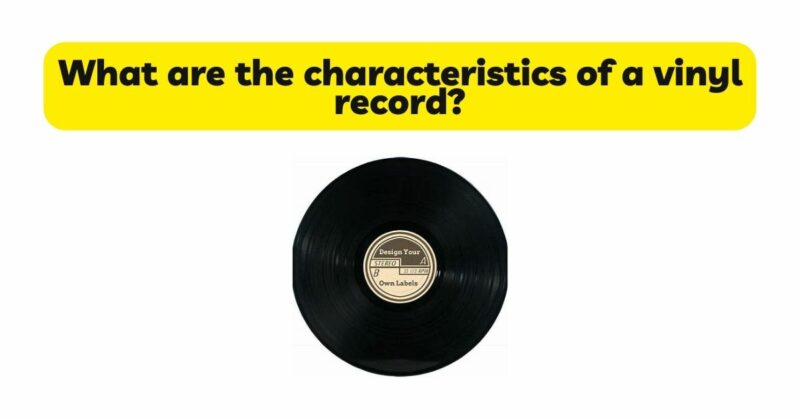Vinyl records have long been celebrated for their distinct sound and unique listening experience. To understand the allure of vinyl, it is essential to explore the characteristics that set this medium apart from others. In this article, we will delve into the multifaceted characteristics of vinyl records, unravelling their sonic signature and the qualities that contribute to their enduring appeal.
- Analog Warmth and Richness: One of the hallmark characteristics of vinyl records is the analog warmth and richness they possess. Vinyl sound is often described as having a certain tonal quality that is pleasing to the ear. The analog nature of vinyl reproduction introduces subtle harmonics and harmonic distortions that contribute to a warm and full-bodied sound, adding depth and richness to the listening experience.
- Tactile Engagement and Rituals: Vinyl records offer a unique tactile engagement that sets them apart from other audio formats. Handling a vinyl record, carefully placing it on the turntable, and manually lowering the needle creates a sense of connection and engagement with the music. The rituals and physical interaction involved in vinyl playback enhance the overall listening experience, making it a multisensory journey.
- Dynamic Range and Expressiveness: Vinyl records excel in capturing the dynamic range and expressiveness of music. The format preserves the subtle variations in volume, allowing for faithful reproduction of delicate nuances and the powerful crescendos that create emotional impact. Vinyl’s ability to faithfully capture the dynamic range contributes to a more engaging and immersive listening experience.
- Distinctive Tonal Balance: Vinyl records often exhibit a distinctive tonal balance that sets them apart from other audio formats. The interplay between frequency ranges, including the lower bass frequencies, midrange, and treble, contributes to a unique tonal signature. This tonal balance can enhance the enjoyment and emotional connection to the music, creating a more immersive sonic experience.
- Character and Texture: Vinyl records are renowned for their distinct character and textural qualities. The analog nature of vinyl reproduction allows for the reproduction of subtle details, textures, and sonic nuances that are often missed in digital formats. The sound of vinyl has a certain depth and complexity that can bring out the true essence of the music, offering a more immersive and engaging sonic experience.
- Surface Noise and Imperfections: A characteristic feature of vinyl records is the presence of surface noise, such as pops, crackles, and background hiss. While surface noise may be perceived as a drawback to some, it is also an inherent part of the vinyl experience. It contributes to the authenticity and uniqueness of vinyl sound, evoking a sense of nostalgia and connection to the medium’s rich history.
- Intimacy and Presence: Vinyl records have the ability to create an intimate listening experience, with a sense of presence that can transport the listener into the recorded environment. Vinyl sound often imparts a feeling of being “up close and personal” with the music, creating a deeper emotional connection between the listener and the artist.
- Spatial Presentation and Soundstage: Vinyl records offer a unique spatial presentation and soundstage. The format has the ability to create an expansive and three-dimensional sonic environment. Instruments and vocals are often presented with precision and clarity, allowing the listener to experience the music as if in a live setting. Vinyl’s analog nature provides a more nuanced representation of spatial cues, contributing to a more immersive and realistic sonic experience.
- Artistic Intent and Authenticity: Vinyl records have a long-standing tradition as an artistic medium. Artists and producers often consider the unique characteristics and limitations of vinyl during the mastering and production processes. Vinyl sound is a faithful representation of the artist’s intent, capturing the nuances and authenticity of the original recording. The sonic characteristics of vinyl contribute to an authentic and true-to-life listening experience.
- Emotional Connection and Nostalgia: Vinyl records evoke a sense of emotional connection and nostalgia. The characteristics of vinyl sound, including warmth, richness, and surface noise, contribute to a unique listening experience that transports listeners to a bygone era. The medium’s ability to evoke memories, sentiments, and a connection to music history makes vinyl a beloved and enduring format.
Conclusion: The characteristics of vinyl records create a distinct sonic signature that sets them apart from other audio formats. Vinyl’s analog warmth, tactile engagement, dynamic range, distinctive tonal balance, and textured sound contribute to an immersive and emotionally fulfilling listening experience. Surface noise, imperfections, and the unique spatial presentation further enhance the authenticity and nostalgia associated with vinyl. Understanding and appreciating these characteristics allows music enthusiasts to embrace the sonic beauty and enduring appeal of vinyl records.


